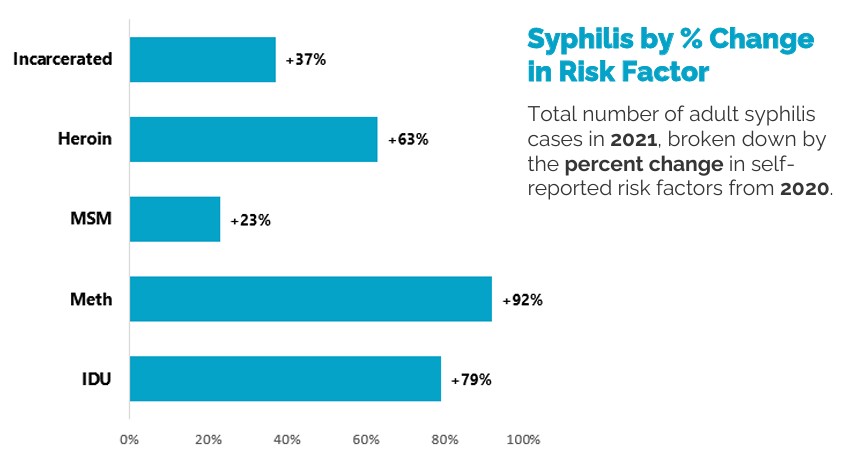Syphilis Cases in Indiana Soar Again in 2021
Since reaching a historic low in 2000 and 2001, the national rate of Primary and Secondary (P&S) syphilis has increased almost every year, increasing 28.6% during 2020 to 2021. Rates increased among males and females, in all regions of the United States, and in all age groups.
In Indiana, the rate of P&S syphilis increased 38% from 2020 to 2021. Early non-primary/non-secondary syphilis rates for the state also increased (+33%), while late or unknown duration syphilis rates increased the most of all stages, by 73%. Notable risk factors among syphilis cases include men who have sex with other men, incarceration in the past year, use of both injected and non-injected drugs like methamphetamines and heroin, and injection drug use in general.

Congenital Syphilis concerns
One of the most notable increases for adult syphilis cases in Indiana is among females of child-bearing age. During 2020 to 2021, syphilis cases increased by 87% among this group, compared to only a 36% increase among their male counterparts. Correspondingly, the increase in syphilis cases among heterosexual persons from 2020 to 2021 was about three times higher than the increase among gay and bisexual persons in Indiana (74% v. 29%). These statistics led to the highest number of congenital syphilis cases the state has seen ever in 2022.
Of the 38 babies with congenital syphilis in 2022, some common risk factors have emerged. A majority of cases were located in Marion County and had mothers with a history of injection drug use/meth use, unstable housing, and domestic violence. Lack of prenatal care was also a concern among cases. 37 women had live births and unfortunately, one baby was a stillbirth.
2021 Fast Facts
• ~14,500 gonorrhea cases, a rise of 22% over five years
• ~34,750 chlamydia cases, slight over five years
• ~1,980 syphilis cases. A rise of 150% over five years
• Cases of syphilis are five times higher among women over the past 5 years.
• Proportionally among men, syphilis increased most among heterosexual men in the past 5 years (+230%).
• Over the last decade, IN reported an average of four cases of congenital syphilis per year. Preliminarily for 2022, there are 38 cases
CONGENITAL SYPHILIS IS 100% PREVENTABLE.
Related STD information
Disparities still seen among Gonorrhea cases
Last year, this report highlighted that in 2020, gonorrhea was disproportionately affecting African-Americans in Indiana. In 2021, this still holds true with 41% of cases being reported for this racial group. Rates of high gonorrhea burden intersected with rates of high poverty, single parent homes, and households with no vehicle for transportation. Social vulnerabilities should be considered when intervening with increasing gonorrhea diagnoses.
Disseminated Gonorrhea
Over the last three years, cases of DGI have increased drastically in Indiana. In 2020, there were 9 reported cases; 23 cases were reported in 2022 - more than a 150% increase. Some of the most commonly reported risk factors overlap with the 2019 DGI outbreak in southwestern Michigan. With reporting being required for DGI now, the STD Surveillance team anticipates additional increases over the next few years.
Some of the most commonly reported risk factors among the 2022 cases include homelessness, methamphetamine use, and sharing needles/injection equipment or having sex with a known IDU.
CDC releases 2021 STD Surveillance Report
Sexually Transmitted Disease Surveillance, 2021 provides the most current and complete data for nationally notifiable sexually transmitted infections (STIs). In 2021, chlamydia, gonorrhea, and syphilis continued to increase in the United States. Disruptions in STI-related prevention and care services due to the COVID-19 pandemic likely continued in 2021, but the impact was most acute in 2020. While the pandemic exposed shortcomings within public health, the nation’s response offers lessons learned that could help reverse rising STI trends.
